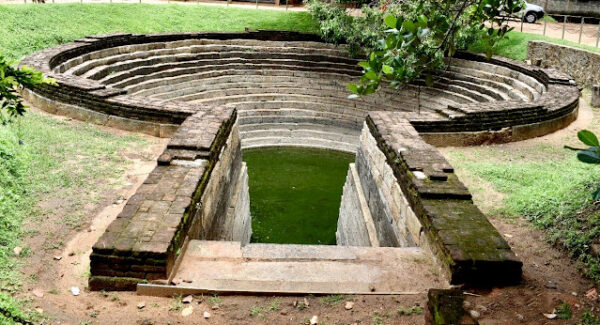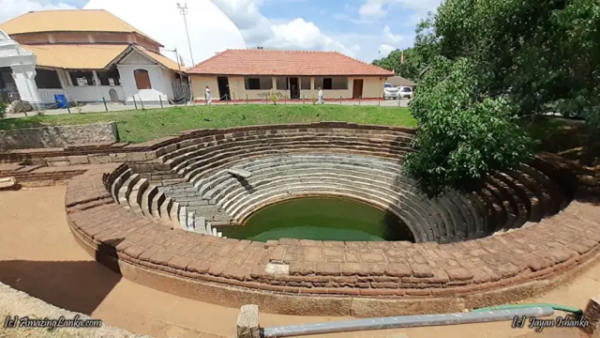General
“Yathuru Pokuna” – amazing craftsmanship of Anuradhapura era By Arundathie Abeysinghe






The design of “Yathuru Pokuna” (Key Pond) resembles a key. According to scholars, the Ponds have been utilized to obtain water for the rituals of the Bodhigara (Bo tree shrine) of Jethawanaramaya Monastery.
According to *Mahawamsa, these ponds (also known as wells) would have been constructed during the era of King Agghabodhi II of *Anuradhapura Kingdom in the 7th century (608 to 618).
These ponds are circular in shape and are not much deep. The walls of the ponds are constructed with bricks and steps of the ponds are made out of granite. There is a flight of stairs in each pond to facilitate one to descend to the bottom of the ponds and collect water by hand.
Out of the three ponds, “Yathuru Pokuna number one” at Jethawanaramaya has the best resemblance to a key. The pond gradually enlarges itself from the bottom to the top.
According to scholars, these ponds have been built for water requirements of the monks of the Diyasen Paya Chapter House (Uposathagara) of the Jethawanaramaya Monastery.
Architects and engineers marvel at the ingenious creation of the structure of the ponds, as during this era, there were no modern tools, equipment nor machinery to construct such a marvelous creation. Although, not protected or preserved well, they are in immaculate condition.
Although, situated in close proximity to Jethawanaramaya and popular Buddhist sites in Anuradhapura, Yathuru Pokuna is a location, rarely visited by tourists.
Image courtesy – amazinglanka.com & theperfecttours.com
Buddhist Railing at Jetawana Monastery – unique structure of yesteryear
By Arundathie Abeysinghe


- Anuradhapura – A major city in Sri Lanka (former Ceylon), the capital of Anuradhapura District. Anuradhapura was one of the ancient capitals of Sri Lanka and is famous for its well-preserved ruins of Sri Lankan civilization. Founded in the 4th century, Anuradhapura was the capital of Sri Lanka until the beginning of the 11th century. Anuradhapura is considered sacred to Buddhists and there are monasteries, stupas within an area of 40 square kilometers. Anuradhapura was declared as the “Sacred City of Anuradhapura” and a World Heritage Site by UNESCO in 1982.
- Arhat Mahinda – The profoundly sapient Thera arrived in Sri Lanka (former Ceylon) as requested by his father, Emperor Asoka of India (264-267 BC). With the advent of Arhat Mahinda and establishment of Buddhism in Sri Lanka, a socio-religious revolution took place in Sri Lanka changing the life, culture and civilization of people.
- Jethawanaramaya Monastery – One of the major Buddhist Monasteries of Sri Lanka founded by King Mahasena (276-303 AC). The Monastery was constructed in the Nandana Pleasure Garden, where the great Buddhist missionary *Arhat Mahinda preached sermons for seven consecutive days.
- Mahavihara Buddhist Monastery – Founded in the late 3rd century BC in Anuradhapura, the ancient capital of Ceylon (present Sri Lanka), Mahavihara Buddhist Monastery is a significant and large Buddhist monastery. King Devanampiya Tissa of Anuradhapura Kingdom (247–207 BCE) founded the Monastery. According to chronicles, during the 5th century, the Monastery had been a renowned and the most sophisticated university in southern Asia. Hence, many international scholars had resided in it and learnt many disciplines.
- Mahawamsa – “Great Chronicle” or “Great Dynasty” in Sinhala is the most significant work of Sri Lankan origin written in Pali Language. This Chronicle describes life and times of Sri Lankans from the arrival of Vijaya in 43 BC to the reign of King Mahasena from sixth century BC to fourth century AD. Culavamsa (lesser chronicle) covers the period from fourth century AD to British takeover of Sri Lanka in 1815. Mahavamsa consists of three parts covering a historical record of over two millennia. It is considered as the world’s longest unbroken historical record.
- Ruwanweliseya – One of the glorious ancient stupas situated in Anuradhapura constructed by King Dutugemunu (161 BC to 137 BC) who became king after a war in which Chola King Elara was defeated. Ruwanweliseya is also known as “Maha Stupa” meaning the “great dagoba”, “Swarnamali Chaitya”, “Suvarnamali Mahaceti” as well as “Rathnamali Dagaba”. One of the world’s tallest ancient monuments, Ruwanweliseya is 103 meters in height with a circumference of 290 meters. According to chronicles, the original stupa was about 55 meters in height and was renovated by many kings.








